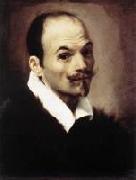 |
BORGIANNI, Orazio -- Click Here
|
|
Italian Baroque Era Painter, 1578-1616
Orazio Borgianni (c. 1575 - buried 15 January 1616) was an Italian painter and etcher of the Mannerist and early-baroque periods. He was the stepbrother of the sculptor and architect Giulio Lasso.
Borgianni was born in Rome, where he was documented in February 1604. He was instructed in the art of painting by his brother, Giulio Borgiani, called Scalzo. The patronage by Philip II of Spain induced him to visit that Spain, where he signed an inventory in January 1605. He returned to Rome from Spain after April 1605 at the height of his career, and most of the work of his maturity was carried out 1605-16. In Spain, he signed a petition to begin an Italianate academy of painting and executed a series of nine paintings for the Convento de Portacoeli, Valladolid, where they remain. From his time in Spain, there remain two of his paintings in the Prado Museum: St Christopher and the Stigmatization of St Francis.
On his return to Rome he was patronized by the Spanish ambassador, for whom he painted several pictures, and he was also employed in painting for the churches. He painted as late as 1630. after which he returned to Spain. He frescoed in the apse of the church of San Silvestro in Capite in Rome, a Martyrdom of S.Stefano I and a Messengers of Constantine call on Saint Silvestro (1610). His canvas of San Carlo Borromeo in the church of San Carlo alle Quattro Fontane (1612) is an eclectic and emotive synthesis of both Carracci and tenebrist styles. The influence of Caravaggio is also evident in a painting of the same saint (1616) now in the Hermitage Museum. A lively self-portrait of an earnest, somewhat foppish Borgianni is in the Rome Galleria Nazionale d'Arte Antica. |
|
|
|
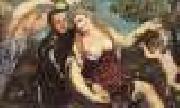 |
BORDONE, Paris -- Click Here
|
|
Italian High Renaissance Painter, 1500-1571
Bordone was born at Treviso, but had moved to Venice by late adolescence. He apprenticed briefly and unhappily (according to Vasari) with Titian. Vasari may have met the elder Bordone.
From the 1520s, we have works by Bordone including the Holy Family in Florence, Sacra Conversazione with Donor (Glasgow), and Holy Family with St. Catherine (Hermitage Museum). The St. Ambrose and a Donor (1523) is now in Brera. In 1525-6, Bordone painted an altarpiece for the church of S. Agostino in Crema, a Madonna with St. Christopher and St George (now in the Palazzo Tadini collection at Lovere). A second altarpiece, Pentecost, is now in Brera gallery.
In 1534-5, he painted his large-scale masterpiece for the Scuola di San Marco a canvas of the Fisherman delivering the Marriage Ring of Venice to the Doge (Accademia). However, when this latter painting is compared to the near-contemoporary, and structurally similar, Presentation of the Virgin, Bordone's limitations, his use of superior perspective, which creates dwarfed distant perspectives, and limited coloration relative to the brilliant tints of Titian.
Bordone is best at his smaller cabinet pieces, showing half-figures, semi-undressed men and women from mythology or religious stories in a muscular interaction despite the crowded space.
|
|
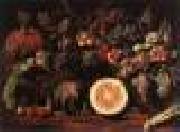 |
BONZI, Pietro Paolo -- Click Here
|
|
ca. 1576, Cortona, d. 1636,
Roma
Pietro Paolo Bonzi (c. 1576-1636) also known as il Gobbo dei Carracci (hunchback of the Carracci) or il Gobbo dei Frutti (of fruits), was an Italian painter, best known for his landscapes and still-lifes.
he was born in Cortona, he was part of the circle of Annibale Carracci and Domenichino, and trained under Giovanni Battista Viola in Rome. In Rome, he worked for Cardinal Pier Paolo Crescenzi in Rome. There are only two still-life paintings known with his signature; he thus forms one of the first Italian artists in Rome working in this style. The Giustiniani inventories of 1638 cite paintings by Bonzi and other still-lifes are documented in the 1670 inventory of Principe Lorenzo Onofrio Colonna's collection. He also worked in fresco and in 1622-23 worked with Pietro da Cortona on the ceiling of a gallery in the Palazzo Mattei di Giove. Other commissions cited by Baglione include his work in the Palazzo Pallavicini-Rospigliosi. |
|
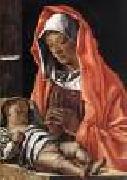 |
BONSIGNORI, Francesco -- Click Here
|
|
Italian painter, Veronese school (b. 1455, Verona, d. 1519, Caldiero)
Italian painter. His father, Albertus Bonsignori, was reputedly an amateur painter; and besides Francesco, the oldest and most talented of his children, three other sons, including Bernardino (c. 1476-c. 1520) and Girolamo (b c. 1479), are also recorded as painters. Barely 20 paintings and fewer than a dozen drawings have been attributed to Francesco Bonsignori. |
|
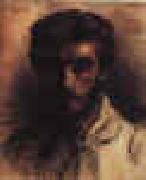 |
Bonnat, LEon -- Click Here
|
|
French, 1833-1922.French portrait and historical painter. He is best known for his portraits of famous men, including Thiers, Victor Hugo, and Dumas fils. Bonnat is represented in the Metropolitan Museum. |
|
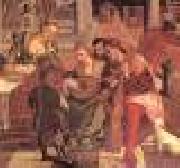 |
BONIFACIO VERONESE -- Click Here
|
|
Italian Painter, ca.1487-1553 |
|
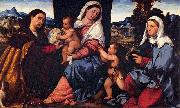 |
Bonifacio de Pitati -- Click Here
|
|
painted Sacra Conversazione in 1515 |
|
 |
Bonifacio Bembo -- Click Here
|
|
Italian Early Renaissance Painter, active 1444-1477 |
|
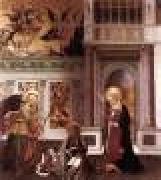 |
BONFIGLI, Benedetto -- Click Here
|
|
Italian painter, Umbrian school (b. ca. 1420, Perugia, d. 1496, Perugia)
Benedetto Bonfigli (c. 1420?CJuly 8, 1496) was an Italian painter of the Quattrocento born in Perugia, and active around Umbria. He is also known as Buonfiglio. He was the teacher of the painter Pietro Perugino.
His earliest work was an ' Annunciation,' originally in the Orfanelli at Perugia. His masterpiece is a series of frescoes in the Palazzo del Consiglio in the same city, which represent the Lives of St. Louis of Toulouse and St. Herculanus; they were begun in 1454 and not finished in 1496, in which year Bonfigli's will is dated. An Adoration of the Magi (c. 1460) was painted for San Domenico. A Banner (gonfalone) was painted in 1465 for the brotherhood of San Bernardino, and representing the deeds of their patron saint; another Gonfalone painted for the brotherhood of San Fiorenzo in 1476, in honor of the Virgin, who had been prayed to intercede for the cessation of the plague. He painted a Virgin of Mercy' (1478) for the church of the Commenda di Santa Croce; and several others in and around Perugia. He was much influenced by Domenico Veneziano and Pietro della Francesca. He also painted frescoes of Sant Ercolano and San Ludovico (1454) for the Palazzo del Consiglio. He died in Perugia.
|
|
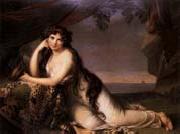 |
BONE, Henry -- Click Here
|
|
British, 1755-1834,Cornish enamel painter, was born at Truro. He was much employed by London jewellers for small designs in enamel, before his merits as an artist were well known to the public. In 1800 the beauty of his pieces attracted the notice of the Royal Academy, of which he was then admitted as an associate; in 1811 he was made an academician. Up to 1831 he executed many beautiful miniature pieces of much larger size than had been attempted before in England; among these his eighty-five portraits of the time of Queen Elizabeth, of different sizes, from 5 by 4 to 13 by 8 in. are most admired. They were disposed of by public sale after his death. His Bacchus and Ariadne, after Titian, painted on a plate, brought the great price of 2200 guineas. He had 2 sons, who were also notable enamallists: Henry Pierce Bone & Robert Trewick Bone. |
|
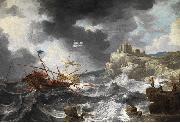 |
Bonaventura Peeters -- Click Here
|
|
(Antwerp, 23 July 1614 - Hoboken (Antwerp), 25 July 1652) was a Flemish Baroque painter who specialized in seascapes and shipwrecks, known as Zeekens (small seascapes).
Peeters, brother of the seascape painters Jan Peeters I, Gillis Peeters, and Catharina Peeters, learned to paint from his father, who became a master in Antwerp's guild of St. Luke in 1607 - 1608, and his earlier works are related to the tonal phase of Dutch landscape painting. Later paintings, however, reflect the stronger colors of Italianate classicism. This shift follows the general changes in artistic style at the time. Like his brother Jan, dramatic shipwrecks with dark billowy clouds, form a significant part of his oeuvre, as do serene ports and "portraits" of ships.Also, while many of Peeters's paintings reflect actual locations, and he may have even travelled along the coast of Scandinavia, his many views of far-away Mediterranean and Middle Eastern ports reflect a growing taste for the exotic and are probably inspired from fantasy and from prints. This tradition developed simultaneously in Flemish painting and in Dutch Golden Age painting, with many artists, including Peeters, working in both Antwerp and in the Dutch Republic. |
|
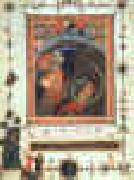 |
Bonaguida, Pacino di -- Click Here
|
|
Italian, active 1303-1330 |
|
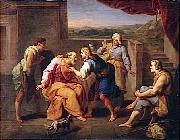 |
Bon Boullogne -- Click Here
|
|
(bapt. February 22, 1649 - May 17, 1717) was a French painter.
Boullogne was born in Paris, a son of the painter Louis Boullogne;[1] he was regarded as the most gifted of his children. He took his first lessons from his father, whom he is thought to have assisted in the Grande Galerie of the Louvre. Through his father, who presented a half-length figure of St John by Bon to Jean-Baptiste Colbert, Contrôleur General des Finances, he was sent to the Academie de France in Rome as a Pensionnaire du Roi. In this capacity, he made copies of famous works, in particular some frescoes by Raphael in the Vatican Loggie, intended for reproduction as Gobelins tapestries. The period he then spent in Lombardy helped to complete his training. He studied the work of Antonio da Correggio and the Annibale Carracci, as well as Guido Reni, Domenichino and Francesco Albani. Bones painting, especially the mythological work, shows great affinities with the work of the Bolognese school, which was also to be found in the royal collections. Also of influence to Bon was Nordic art, as demonstrated in his female portraits framed by plant like motifs, a device taken up by his pupil Robert Tournieres. He died in Paris.
|
|
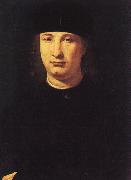 |
BOLTRAFFIO, Giovanni Antonio -- Click Here
|
|
Italian High Renaissance Painter, ca.1466-1516
Italian painter and draughtsman. A pupil of Leonardo da Vinci, he was active mainly in Milan and was particularly noted as a portrait painter. |
|
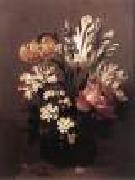 |
BOLLONGIER, Hans -- Click Here
|
|
Dutch painter, Haarlem school (b. ca. 1600, Haarlem, d. ca. 1675, Haarlem)
Hans Gillisz. Bollongier or Boulenger (Haarlem, 1600-idem, 1645) was a still life Dutch painter. |
|
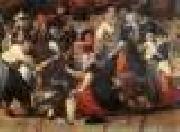 |
BOL, Hans -- Click Here
|
|
Flemish Northern Renaissance Painter, 1534-1593
Hans Bol (1534?C1593), Flemish artist, received his early training from his two uncles who were also painters. He then was the apprentice to a Mechelen watercolorist and tempera painter at the age of fourteen. Because Bol??s watercolors became so widely reproduced, he began creating miniatures on parchment. The technique earned him many international clients and a good income. In addition, Bol also produced several oil paintings, illuminated manuscripts, drawings, and engravings. He preferred to create landscapes, mythological, allegorical and biblical scenes, and genre paintings. |
|
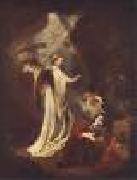 |
BOL, Ferdinand -- Click Here
|
|
Dutch Baroque Era Painter, 1616-1680
Ferdinand was born in Dordrecht as the son of a surgeon, Balthasar Bol.[2] Ferdinand Bol was first an apprentice of Jacob Cuyp in his hometown and/or of Abraham Bloemaert in Utrecht. After 1630 he studied with Rembrandt, living in his house in Sint Antoniesbreestraat, then a fashionable street and area for painters, jewellers, architects, and many Flemish and Jewish immigrants.[3] In 1641 Bol started his own studio.
In 1652 he became a burgher of Amsterdam, and in 1653 he married Elisabeth Dell, whose father held positions with the Admiralty of Amsterdam and the wine merchants' guild, both institutions that later gave commissions to the artist. Within a few years (1655) he became the head of the guild and received orders to deliver two chimney pieces for rooms in the new town hall designed by Jacob van Campen, and four more for the Admiralty of Amsterdam.
Portrait of a Woman Dressed as a Huntress by Ferdinand Bol, courtesy Figge Art MuseumBy this time Bol was a popular and successful painter. His palette had lightened, his figures possessed greater elegance, and by the middle of the decade he was receiving more official commissions than any other artist in Amsterdam.[4] Godfrey Kneller was his pupil.[5] Bol delivered four paintings for the two mansions of the brothers Trip, originally also from Dordrecht.[6]
Bol's first wife died 1660. In 1669 Bol married for the second time to Anna van Arckel, widow of the treasurer of the Admiralty, and apparently retired from painting at that point in his life.[7]In 1672 the couple moved to Keizersgracht 472, then a newly designed part of the city, and now the Museum van Loon. Bol served as a governor in a Home for Lepers. Bol died a few weeks after his wife, on Herengracht, where his son, a lawyer, lived.
Probably his best known painting is a portrait of Elisabeth Bas, the wife of the naval officer Joachim Swartenhondt and an innkeeper near the Dam square. This and many other of his paintings would in the 19th century be falsely attributed to Rembrandt. |
|
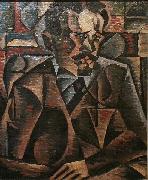 |
Bohumil Kubista -- Click Here
|
|
(1884 - 1918) was a Czech painter and art critic, one of the founders of Czech modern painting. He studied at the School of Applied Arts in Prague, but left in 1906 to study at the Reale Istituto di Belle Arti in Florence. He, Emil Filla, Antonin Prochezka, and five others founded Osma (The Eight), an Expressionist-oriented group of artists.
Kubišta came to his individual expression gradually, at first he was influenced by the work of Vincent van Gogh and Paul Cezanne. He educated himself in in philosophy and optics, and studied colour and the geometrical construction of painting.
Kubišta, like several other Czech artists of his generation, was strongly affected by the 1905 Edvard Munch exhibition in Prague. Together with Emil Filla he established the artistic group Osma in 1907. He worked in an Expressionist style until 1910, and exchanged ideas with German painters in Die Bre - ke. He also developed visual ideas learned from the work of Cezanne. His later style (approximately from 1911) was strongly influenced by cubism and expressionism. Expressionist elements, particularly his use of color but also his subject matter, immediately distinguish Kubištaes cubist work from that of founding Paris Cubists Picasso and Braque. He studied color theory, analyzing the harmonic and compositional principles of painters such as El Greco, Eugene Delacroix, Vincent van Gogh, and Edvard Munch. He also paid close attention to mathematical and geometric principles. Around 1911, he became acquainted with Jan Zrzavý and the artistic group Sursum.
He died prematurely during the global 1918 flu pandemic which ravaged Europe after the First World War.
|
|
 |
Bogdan Villevalde -- Click Here
|
|
painted Feat of Cavalry Regiment at the battle of Austerlitz in 1805. |
|
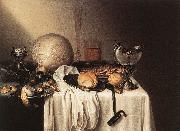 |
BOELEMA DE STOMME, Maerten -- Click Here
|
|
Dutch painter (active 1642-1664 in Haarlem) |
|
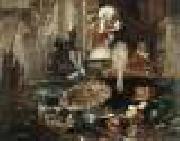 |
BOEL, Pieter -- Click Here
|
|
Flemish Baroque Era Painter, 1622-1674
Flemish painter, draughtsman and etcher. He came from an artistic family: his father Jan Boel (1592-1640), was an engraver, publisher and art dealer; his uncle Quirin Boel I was an engraver; and his brother Quirin Boel II (1620-40) was also a printmaker. Pieter was probably apprenticed in Antwerp to Jan Fyt, but may have studied previously with Frans Snyders. He then went to Italy, probably visiting Rome and Genoa, where he is supposed to have stayed with Cornelis de Wael. None of Boel's work from this period is known. In 1650 he became a master in the Antwerp Guild of St Luke (having given his first name as Jan, not Pieter). His marriage to Maria Blanckaert took place at about the same time. Boel dated only a few of his paintings, making it difficult to establish a chronology. He is best known for his hunting scenes, some of which clearly show his debt to Snyders, but the dominant influence on his work was that of Fyt, particularly evident in his emphatic brushwork. However, Boel was more restrained both in his treatment and in his handling of outline. He also borrowed the theme of open-air hunting still-lifes (e.g. Feathered Game with Three Dogs; Madrid, Prado) from Fyt, but he painted other subjects as well, such as the monumental Vanitas Still-life (e.g. 1633; Lille, Mus. B.-A.). |
|
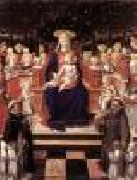 |
BOCCATI, Giovanni -- Click Here
|
|
Italian Painter, ca.1420-1487 |
|
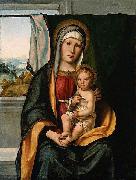 |
Boccaccio Boccaccino -- Click Here
|
|
(c. 1467 - c. 1525) was a painter of the early Italian Renaissance, belonging to the Emilian school. He is profiled in Vasari's Le Vite delle pie eccellenti pittori, scultori, ed architettori (or, in English, Lives of the Most Excellent Painters, Sculptors, and Architects).
He was born in Ferrara and studied there, probably under Domenico Panetti. Few facts of his life are known. His principal artistic activity was in Venice, Ferrara, and especially in Cremona, where he founded a school in which Garofalo was a pupil.
His most celebrated achievement is the frescoes in the Cathedral of Cremona (1506-1519) representing the Birth of the Virgin and some subjects from her life. His position there was taken over by Altobello Melone. His remaining works, which include the Marriage of Saint Catherine (Accademia), the Virgin and Child with Four Saints (Venice, San Giuliano), the Virgin and Two Saints (Cremona, San Quirilo), and the Holy Family (Paris, Louvre), are considered by Lanzi remarkable for richness of drapery, variety of color, spirit and grace of attitude, and harmony of landscape. Several works formerly attributed to Pietro Perugino, Pinturicchio, and Garofalo are now ascribed to Boccaccino.
His son and pupil Camillo Boccaccino (1501-46) was a painter at Cremona.
|
|
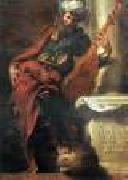 |
BOCCACCINO, Camillo -- Click Here
|
|
Italian painter, Cremonese school (b. 1504/5, Cremona, d. 1546, Cremona)
Camillo Boccaccino (c. 1504 - 1546) was an Italian painter of the Renaissance period, active mainly in Cremona and regions of Lombardy. He was the son and pupil of the painter Boccaccio Boccaccino. He was known to Gian Paolo Lomazzo and Giorgio Vasari. He painted the four evangelists (1537) in the niches of the cupola of San Sigismondo at Cremona. |
|
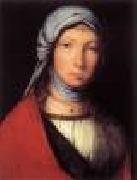 |
BOCCACCINO, Boccaccio -- Click Here
|
|
Italian painter, Cremonese school (b. before 1466, Ferrara, d. 1524/25, Cremona)
He is first recorded in 1493 in Genoa, where he contracted to paint the high altarpiece (untraced) for S Maria della Consolazione. In 1497 he was extracted from prison in Milan by the agent of Ercole I d'Este, Duke of Ferrara, and worked for the Duke in Ferrara until 1500. Perhaps as a consequence of having killed his common-law wife he then left, presumably for Venice, where he is recorded as residing in 1505. A fresco in Cremona Cathedral is dated 1506. |
|
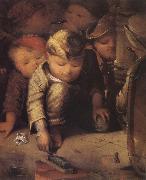 |
Blythe David Gilmour -- Click Here
|
|
American Painter, 1815-1865
He began his career as an itinerant portrait painter in the early 1840s and became one of the leading satirical artists in America by the beginning of the Civil War. Self-taught, from 1840 to 1850 he worked in East Liverpool, OH, and Uniontown, PA, and nearby towns and villages, painting rather stiff likenesses of the local gentry. He also carved a monumental polychrome wooden statue of Marie-Joseph, Marquis de Lafayette for the Uniontown courthouse and painted a landscape panorama of the Allegheny mountains, which he took on tour through Maryland, Pennsylvania and Ohio. |
|
|
|
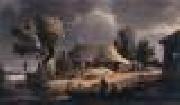 |
BLOOT, Pieter de -- Click Here
|
|
Dutch painter (b. 1601, Rotterdam, d. 1658, Rotterdam)
|
|
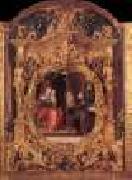 |
BLONDEEL, Lanceloot -- Click Here
|
|
Flemish Northern Renaissance Painter, 1498-1561
South Netherlandish painter, draughtsman, designer, architect, civil engineer, cartographer and engraver. He is said to have trained as a bricklayer, and the trowel he used to add as his housemark next to his monogram LAB testifies to this and to his pretensions as an architectural designer. In 1519 he was registered as a master painter in the Bruges Guild of St Luke, where he chose as his speciality painting on canvas. The following year he collaborated with the little-known painter Willem Cornu in designing and executing 12 scenes for the Triumphal Entry of Emperor Charles V into Bruges. From then onwards Blondeel received regular commissions, mainly as a designer and organizer. Records of legal actions show that he was sometimes late with commissions; he took seven years to execute a Last Judgement ordered in 1540 for the council chamber at Blankenberge, and in 1545 the Guild of St Luke summoned him for his failure to supply their guild banner on time. Blondeel was married to Kathelyne, sister of the wood-carver Michiel Scerrier; of the two daughters of this marriage, the eldest, Maria, married the tapestry-weaver Andries Hansins before 1542 and the younger, Anna, married Blondeel's pupil, the painter Pieter Pourbus, before 1545. |
|
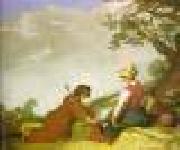 |
BLOEMAERT, Abraham -- Click Here
|
|
Dutch Mannerist Painter, ca.1564-1651
Abraham Bloemaert (1566, Gorinchem - January 27, 1651, Utrecht), was a Dutch painter and printmaker in etching and engraving.
Bloemaert was the son of an architect, who moved his family to Utrecht in 1575, where Abraham was first a pupil of Gerrit Splinter (pupil of Frans Floris) and of Joos de Beer. He then spent three years in Paris, studying under several masters, and on his return to his native country received further training from Hieronymus Francken. In 1591 he went to Amsterdam, and four years later settled finally at Utrecht, where he became dean of the Guild of St. Luke.
He excelled more as a colourist than as a draughtsman, was extremely productive, and painted and etched historical and allegorical pictures, landscapes, still-life, animal pictures and flower pieces. Among his pupils are his four sons, Hendrick, Frederick, Cornelis and Adriaan (all of whom achieved considerable reputation as painters or engravers), the two Honthorsts, Ferdinand Bol and Jacob Gerritsz Cuyp. |
|
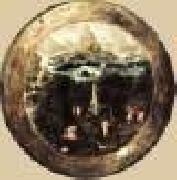 |
BLES, Herri met de -- Click Here
|
|
Flemish Northern Renaissance Painter, ca.1510-1550
Flemish painter. Both van Mander and Lampsonius recorded Bouvines as his birthplace, although Guicciardini gave it as Dinant. The identification of Herri met de Bles with Herry de Patinir, who was a master of the Antwerp Guild of St Luke in 1535, is generally accepted. He may have been related to Joachim Patinir, possibly a nephew. In the Pictorum aliquot celebrium Germaniae Inferioris effigies (Antwerp, 1572) of Domenicus Lampsonius, Henricus Blesius Bovinati pictori is portrayed aged 40, sporting the type of clothing and beard that were fashionable in 1550. |
|
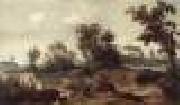 |
BLEKER, Gerrit Claesz -- Click Here
|
|
Dutch painter (active 1625-1656 in Haarlem) |
|
 |
Blarenberghe -- Click Here
|
|
was the name of a dynasty of painters, originally from French Flanders but the most famous descendants lived in Lille and Paris in France. They were all descendants from Joris van Blarenberghe (1612-1670).
The first two painters were Hendrick van Blarenberghe (1646-1712) and his son Jacques-Guillaume van Blarenberghe (1679-1742). Their style was still heavily influenced by the Flemish Baroque style. Jacques-Guillaume had two painting sons, Louis-Nicolas Van Blarenberghe (15 July 1716 - 1 May 1794) and Henri Desire van Blarenberghe (1734-1812).
Louis-Nicolas had a son who was also a painter and with who he often collaborated: Henri-Joseph van Blarenberghe (24 November 1750 - 1 December 1826). Together with his father, they stayed at the Palace of Versailles, where they worked as miniaturists for the high society of their day. They were especially famous for their paintings on snuff boxes. Louis-Nicolas also worked as official campaign painter of the French court, following the French army as a war reporter. Two of his daughters, Catherine-Henriette and Isabelle, were chamber maids to the children of the French kings. The works of Louis-Nicolas and Henri-Joseph were collected in profusion in the 19th century by the Rothschild family. There is a collection of their work on public display at Waddesdon Manor.
Henri-Joseph painted, besides the miniatures, mainly Panoramic paintings, often in gouache. The subjects were, as with his father, often military, and also included the French revolution. |
|
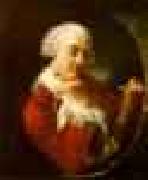 |
Blanchet, Louis-Gabriel -- Click Here
|
|
French Painter, 1705-1772
French painter, active in Rome. He won second place in the Prix de Rome competition in 1727 and thereafter settled in Rome, where he enjoyed the patronage of Nicolas Vleughels, Director of the Acad?mie de France, and the Duc de Saint-Aignan (1684-1776), who at that time was French Ambassador to the Holy See. In 1752 Blanchet painted the Vision of Constantine (Paris, Louvre), a copy of Giulio Romano's fresco in the Sala di Costantino in the Vatican. He was, however, principally a portrait painter. His portrait of Tolozan de Montfort (1756; Lyon, Mus. B.-A.) is a fine example of his elegant, rather nervous style and his distinctive use of colour. In the same year Blanchet executed a portrait of the contemporary painter Johann Mandelberg (1730-86; Copenhagen, Kon. Dan. Kstakad.). Other surviving works of his include St Paul (signed and dated 1757; Avignon, Mus. Calvet) and his full-length portrait of P. P. Lesueur and E. Jacquier (1772; Nantes, Mus. B.-A.). |
|
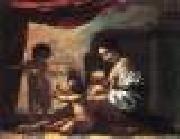 |
BLANCHARD, Jacques -- Click Here
|
|
French Baroque Era Painter, 1600-1638
He trained with his maternal uncle Nicolas Bollery (c. 1550/60-1630) from 1613 to 1618. He then set off for Italy but stopped at Lyon to work in the studio of Horace Le Blanc. Le Blanc left for Paris in 1623, and Blanchard is known to have finished a number of his works left in Lyon, including perhaps the Virgin and Child with a Bishop and a Woman Holding a Baby (Lyon, St Denis). At the end of October 1624 he reached Rome in the company of his brother Jean Blanchard, remaining there until April or May 1626. He was then in Venice until 1628, when he returned to Lyon via Turin. |
|
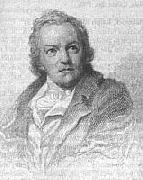 |
Blake, William -- Click Here
|
|
William Blake was an English poet, painter was born November 28, 1757, in London
William Blake started writing poems as a boy, many of them inspired by religious visions. Apprenticed to an engraver as a young man, Blake learned skills that allowed him to put his poems and drawings together on etchings, and he began to publish his own work. Throughout his life he survived on small commissions, never gaining much attention from the London art world. His paintings were rejected by the public |
|
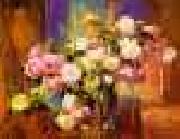 |
Bischoff, Franz -- Click Here
|
|
Austrian, practiced mainly in America, 1864-1929
was an American artist known primarily for his beautiful floral paintings and California landscapes. He was born in Bomen, Austria on January 9, 1864 and as a young teenager immigrated to the United States where he became a naturalized citizen. While in Europe, his early training was focused upon applied design, watercolor and ceramic decorations.After having lived and worked in New York, Fostoria, Ohio and Dearborn, Michigan, Franz Bischoff decided to visit California in 1900 and ultimately chose to settle in Los Angeles in 1906. Shortly after arriving, he started making arrangements to design and build a large Italian Renaissance style home in Pasadena that also became his studio. This landmark home was completed in 1908. Inspired by the California countryside, Bischoff set attempted to capture the area's brilliant light and diverse landscapes. Spending less time with ceramic painting, Bischoff painted local farms, fishing wharfs, and coastal landscapes. Recognized during his career for use of color and vivid composition, his paintings always displayed reverence for nature. |
|
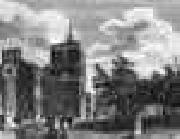 |
Birch, William Russell -- Click Here
|
|
American, 1755-1834 |
|
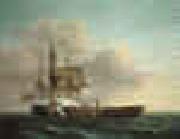 |
Birch, Thomas -- Click Here
|
|
English-born American Painter, 1779-1851
American painter of English birth. He was one of the most important American landscape and marine painters of the early 19th century. He moved to America in 1794 with his father William Birch (1755-1834), a painter and engraver from whom he received his artistic training. The family settled in Philadelphia, where William, armed with letters of introduction from Benjamin West to leading citizens of that city, became a drawing-master. Early in their American careers both Birches executed cityscapes, several of which were engraved. Thomas contributed a number of compositions to The City of Philadelphia in the State of Pennsylvania, North America, as it Appeared in the Year 1800 (1800), a series of views conceived by the elder Birch in obvious imitation of comparable British productions. An English sensibility is also apparent in the many paintings of country estates executed by father and son in the early 19th century These compositions, along with such portrayals of important public edifices in and near Philadelphia as Fairmount Waterworks |
|
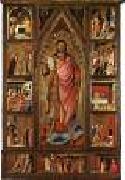 |
BIONDO, Giovanni del -- Click Here
|
|
Italian painter, Florentine school (active 1356-1392 in Florence) |
|
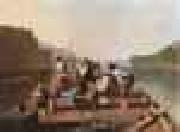 |
Bingham, George Caleb -- Click Here
|
|
American Realist Painter, 1811-1879. American painter. Raised in rural Franklin County, MO, Bingham experienced from an early age the scenes on the major western rivers, the Missouri and the Mississippi, that inspired his development as a major genre painter. During his apprenticeship to a cabinetmaker, he met the itinerant portrait painter Chester Harding, who turned Bingham's attention to art. Teaching himself to draw and compose from art instruction books and engravings, the only resources available in the frontier territories, Bingham began painting portraits as early as 1834. |
|
|
|
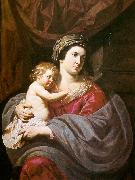 |
Biljert, Jan Hermansz. van -- Click Here
|
|
Dutch, approx. 1597-1671 |
|
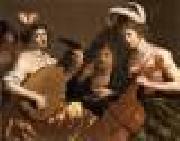 |
BIJLERT, Jan van -- Click Here
|
|
Dutch painter, Utrecht school (b. 1597/98, Utrecht, d. 1671, Utrecht)
Dutch painter. He was the son of the Utrecht glass painter Herman Beerntsz. van Bijlert (c. 1566-before 1615). Jan must have trained first with his father but was later apprenticed to the painter Abraham Bloemaert. After his initial training, he visited France and travelled to Italy, as did other artists from Utrecht. Jan stayed mainly in Rome, where he became a member of the Schildersbent; he returned to Utrecht in 1624. In Rome he and the other Utrecht artists had come under the influence of the work of Caravaggio; after their return home, this group of painters, who became known as the UTRECHT CARAVAGGISTI, adapted the style of Caravaggio to their own local idiom. The Caravaggesque style, evident in van Bijlert's early paintings. |
|
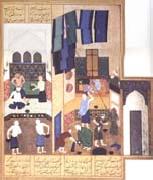 |
Bihzad -- Click Here
|
|
the period of 1465-153
Persian illustrator. The most famous master of Persian painting, he is important both for the paintings he executed and for the wider influence of the style associated with his name. Evidently orphaned at a young age, Bihzad is said to have been raised and trained by MIRAK, a painter and calligrapher employed in Herat by Husayn Bayqara. |
|
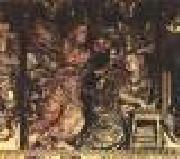 |
BIGARNY, Felipe -- Click Here
|
|
Spanish Sculptor, ca.1480-1542 |
|
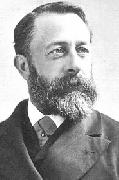 |
Bierstadt, Albert -- Click Here
|
|
The landscape painter
Bierstadt joined a surveying expedition to the western United States in 1858 after studying painting in Germany. |
|
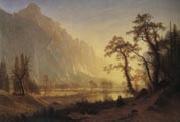 |
Bierstadt Albert -- Click Here
|
|
German-born American Hudson River School Painter, 1830-1902
was a German-American painter best known for his large landscapes of the American West. In obtaining the subject matter for these works, Bierstadt joined several journeys of the Westward Expansion. Though not the first artist to record these sites, Bierstadt was the foremost painter of these scenes for the remainder of the 19th century. Bierstadt was part of the Hudson River School, not an institution but rather an informal group of like-minded painters. The Hudson River School style involved carefully detailed paintings with romantic, almost glowing lighting, sometimes called luminism. Bierstadt was born in Solingen, Germany. His family moved to New Bedford, Massachusetts, in 1833. He studied painting with the members of the D??sseldorf School in D'sseldorf, Germany from 1853 to 1857. He taught drawing and painting briefly before devoting himself to painting. Bierstadt began making paintings in New England and upstate New York. In 1859, he traveled westward in the company of a Land Surveyor for the U.S. government, returning with sketches that would result in numerous finished paintings. In 1863 he returned west again, in the company of the author Fitz Hugh Ludlow, whose wife he would later marry. He continued to visit the American West throughout his career. Though his paintings sold for princely sums, Bierstadt was not held in particularly high esteem by critics of his day. |
|
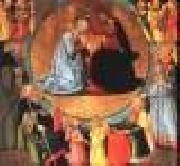 |
BICCI, Nero di -- Click Here
|
|
Italian Early Renaissance Painter, 1419-1491 |
|
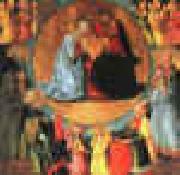 |
Bicci, Neri di -- Click Here
|
|
Italian Early Renaissance Painter, 1419-1491
was an Italian painter of the Renaissance. A prolific painter of mainly religious themes, he was active mainly in Florence and in the medium of tempera. His father was Bicci di Lorenzo (1373-1452). His grandfather, Lorenzo di Bicci (c. 1350-1427) was also a painter in Florence, a pupil of Spinello Aretino. He painted a St. Giovanni Gualberto enthroned, with ten Saints for the church of San Pancrazio. His journals from the years 1453-1475, |
|
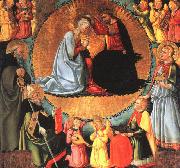 |
Bicci Di Neri -- Click Here
|
|
(1419-1491) was an Italian painter of the Renaissance. A prolific painter of mainly religious themes, he was active mainly in Florence and in the medium of tempera. His father was Bicci di Lorenzo. His grandfather, Lorenzo di Bicci was also a painter in Florence, a pupil of Spinello Aretino.
Neri di Bicci's main works include a St. John Gualbert Enthroned, with Ten Saints for the church of Santa Trinita, an Annunciation (1464) in the Florentine Academy, two altarpieces in the Diocesan Museum of San Miniato, a Madonna with Child Enthroned in the Pinacoteca Nazionale of Siena, and a Coronation of the Virgin (1472) in the abbey church at San Pietro a Ruoti (Bucine. He also painter numerous works in the area of Volterra.
His journals from the years 1453-1475, including the rates of remuneration for his work, are still preserved in the library of the Uffizi Gallery. They are known as Ricordanze.
|
|
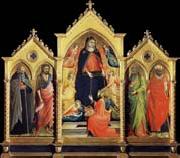 |
Bicci di Lorenzo -- Click Here
|
|
Italian, 1373-1452,was an Italian painter and sculptor, active in Florence. He was born in Florence in 1373, the son of the painter, Lorenzo di Bicci, whose workshop he joined. He married in 1418, and in 1424 was registered in the Guild of Painters at Florence. His son, Neri di Bicci was also a painter and took over the family workshop. Bicci di Lorenzo died in Florence in 1452 and was buried in Santa Maria del Carmine. Following early work - largely frescoes - in collaboration with his father, he received a number of important commissions, including, according to Vasari, from the Medici for a cycle of frescoes of Illustrious Men for the Palazzo Medici. For the Opera del Duomo, he painted frescoes of the apostles. And he painted a Saints Cosmas and Damian and frescoes representing the dedication of the church itself for Sant'Egidio in the hospital of Santa Maria Nuova. His best paintings are now thought to be the Madonna in Trono now in the National Gallery at Parma, the Three stories of St Nicholas triptych in the cathedral of Fiesole, and a Nativity in the church of San Giovannino dei Cavalieri in Florence. |
|
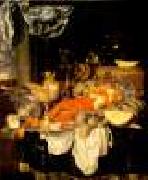 |
BEYEREN, Abraham van -- Click Here
|
|
Dutch Baroque Era Painter, ca.1620-1690
Dutch painter. He painted seascapes as well as fruit, flower, fish, game and banquet still-lifes. He almost always signed these works with his monogram AVB, but he dated only a few. This, together with the fact that he painted diverse subjects simultaneously and his style changed little, makes it difficult to establish a chronology. He became a master in The Hague in 1640 and was related by marriage to the fish painter Pieter de Putter (before 1600-59). Van Beyeren lived in Delft from 1657 to 1661 and was again in The Hague between 1663 and 1669. |
|
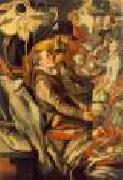 |
BEUCKELAER, Joachim -- Click Here
|
|
Flemish Northern Renaissance Painter, ca.1534-1574
A native of Antwerp, he studied under his uncle, Pieter Aertsen. Many of his paintings contain scenes of kitchen and markets, with religious allusions in the background. His Four Elements series (as of 2004[update], in the National Gallery, London) exemplifies this theme on a large scale. Water, for example, shows a fish market selling twelve kinds of fish, representing the twelve disciples of Jesus. Through an archway in the background we can see Jesus walking on the Sea of Galilee after his resurrection, making fish appear miraculously in empty nets. Beuckelaer's work was influential on painters in Northern Italy, particularly Vincenzo Campi. |
|
 |
Bertram Mackennal -- Click Here
|
|
1863 - 1931,Mackennal was born in Fitzroy a suburb of Melbourne to parents who were both of Scottish descent. His father, John Simpson Mackennal, who was also a sculptor, provided his early training which was followed by studies at the school of design at the Melbourne National Gallery which he attended from 1878 to 1882. Marshall Wood, the English sculptor, who visited Australia in 1880, strongly advised him to go abroad. He left for London in 1882 to study at the National Gallery Schools, and for a time shared a studio with Charles Douglas Richardson and Tom Roberts. In 1884 he visited Paris for further study and married a fellow student, Agnes Spooner. On returning to England he obtained a position at the Coalport china factory as a designer and modeller. In 1886 he won a competition for the sculptured reliefs on the front of Parliament House, Melbourne, and returned to Australia in 1887 to carry these out. While in Australia he obtained other commissions, including the figure over the doorway of Mercantile Chambers, Collins Street, Melbourne. He also met Sarah Bernhardt, who was on a professional visit to Australia, and strongly advised the young man to return to Paris, which he did in 1891. In 1893 he had his first success, when his full length figure "Circe", now at the National Gallery of Victoria, obtained a "mention" at the Salon and created a good deal of interest. It was exhibited later at the Royal Academy where it also aroused great interest, partly because of the prudery of the hanging committee which insisted that the base should be covered. Commissions began to flow in, among them being the figures "Oceana" and "Grief' for the Union Club, Sydney. Two Melbourne commissions brought him to Australia again in 1901, the memorial to Sir William John Clarke at the Treasury Gardens, Melbourne, and the sculptures for the Springthorpe Memorial in Kew. He returned to London, and among his works of this period were the fine pediment for the local government board office at Westminster, a Boer War memorial for Islington, and statues of Queen Victoria for Ballarat, Lahore, and Blackburn. In 1907 his marble group "The Earth and the Elements" was purchased for the National Gallery of British Art under the Chantry Bequest, and in 1908 his "Diana Wounded" was also bought for the nation. This dual success brought Mackennal into great prominence, and he was elected an associate of the Royal Academy in 1909. In the following year he designed the Coronation Medal for King George V and also won the important commission for the obverse design (the monarch's head) of the new coinage needed for the new reign from 1911. This is certainly his most enduring design. His initials, B.M., can be seen on the truncation of the King's neck on the obverse of all British coins of George V. His next important piece of work was the memorial to Gainsborough at Sudbury, which was followed by the memorial tomb of King Edward VII at St. George's Chapel, Windsor. He also did statues of King Edward VII for London, Melbourne, Calcutta and Adelaide. He was the first Australian artist to be knighted.He was created a Knight Commander of the Victorian Order in 1921, and was elected R.A. in 1922. Among his later works were the nude male figure for the Eton War Memorial, the war memorial to the members of both houses of parliament in London, the figures of the soldier and the sailor for the cenotaph in Martin Place, Sydney, the bronze statue of King George V at Old Parliament House, Canberra, and the head of "Victory", presented to the Commonwealth by the artist, also at Canberra. He completed the Desert Mounted Corps memorial at the Suez Canal from the designs of Charles Web Gilbert a little while before his death. He died suddenly at his house, Watcombe Hall, near Torquay, |
|
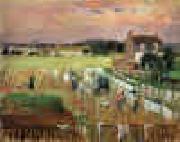 |
Berthe Morisot -- Click Here
|
|
French
1841-1895
Berthe Morisot Galleries
Berthe Morisot (January 14, 1841 ?C March 2, 1895) was a painter and a member of the circle of painters in Paris who became known as the Impressionists. Undervalued for over a century, possibly because she was a woman, she is now considered among the first league of Impressionist painters.
In 1864, she exhibited for the first time in the highly esteemed Salon de Paris. Sponsored by the government, and judged by academicians, the Salon was the official, annual exhibition of the Acad??mie des beaux-arts in Paris. Her work was selected for exhibition in six subsequent Salons until, in 1874, she joined the "rejected" Impressionists in the first of their own exhibitions, which included Paul C??zanne, Edgar Degas, Claude Monet, Morisot, Camille Pissarro, Pierre-Auguste Renoir, and Alfred Sisley. It was held at the studio of the photographer Nadar.
She became the sister-in-law of her friend and colleague, Édouard Manet, when she married his brother, Eugene.
|
|
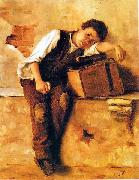 |
Bertha Worms -- Click Here
|
|
painted Missing Naples in 1895 |
|
 |
Bertel Thorvaldsen -- Click Here
|
|
1770-1844 Copenhagen, He was a Danish/Icelandic sculptor. Thorvaldsen was born in Copenhagen in 1770 (according to some accounts, in 1768), the son of an Icelander who had settled in Denmark and there carried on the trade of a wood-carver. This account is disputed by some Icelanders, who claim Thorvaldsen was born in Iceland. Young Thorvaldsen attended Copenhagen's Royal Danish Academy of Art (Det Kongelige Danske Kunstakademi), winning all the prizes including the large Gold Medal. As a consequence, he was granted a Royal stipend, enabling him to complete his studies in Rome, where he arrived on 8 March 1797. Since the date of his birth had never been recorded, he celebrated this day as his "Roman birthday" for the rest of his life. Thorvaldsen's first success was the model for a statue of Jason, which was highly praised by Antonio Canova, the most popular sculptor in the city. In 1803 he received the commission to execute it in marble from Thomas Hope, a wealthy English art-patron. From that time Thorvaldsen's success was assured, and he did not leave Italy for sixteen years. In 1819 he visited his native Denmark. Here he was commissioned to make the colossal series of statues of Christ and the twelve Apostles for the rebuilding of Vor Frue Kirke (from 1922 known as the Copenhagen Cathedral) between 1817 and 1829, after its having been destroyed in the British bombardment of Copenhagen in 1807. |
|
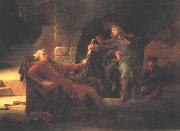 |
Bertalan Szekely -- Click Here
|
|
(May 8, 1835 - August 21, 1910) was a Hungarian Romantic painter of historical themes. "The Discovery of Louis II's Dead Body", "Women of Eger", "Battle of Mohe - s", "Ladislas V" are among the most important of his historical paintings. Szekely is also known for his many murals.
|
|
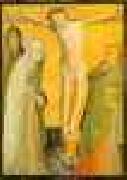 |
Berswordt Altar -- Click Here
|
|
German Gothic Era Painter, active ca.1400]
|
|
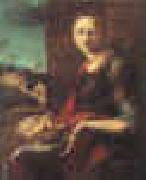 |
Berruguette, Alonso -- Click Here
|
|
Spanish, 1488-1551 |
|
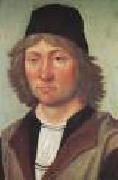 |
BERRUGUETE, Pedro -- Click Here
|
|
Spanish Early Renaissance Painter, ca.1450-1504
Pedro Berruguete (c. 1450 ?C 1504) was a Spanish painter, his art is regarded as a transitional style between gothic and renaissance. Born in Paredes de Nava, Spain, he went to Italy in 1480 and worked in Federigo da Montefeltro's court in Urbino. He came back Spain 1482 and painted in several cities as Sevilla, Toledo and Ávila. He was father of an important sculptor, Alonso Berruguete, considered the most important sculptor in Renaissance Spain. |
|
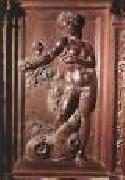 |
BERRUGUETE, Alonso -- Click Here
|
|
Spanish Mannerist Painter and Sculptor, ca.1488-1561
Alonso Berruguete was born in Paredes de Navas, Valladolid, the son of Pedro Berruguete, Spain's first major Early Renaissance painter. Pedro was trained in Italy, and it is understandable that he would want his son to have an Italian formation. Alonso was in Florence from about 1504, the year of his father's death, until about 1517. He also spent time in Rome during this period.
Berruguete's original purpose was to train as a painter, but he had the opportunity to study sculpture under Michelangelo, whom he is said to have assisted in the execution of some works. Berruguete received minor commissions, such as the completion of paintings and sculptures left unfinished by other artists.
On his return to Spain, Berruguete executed an alabaster relief, the Resurrection, for Valencia Cathedral (ca. 1517), which compares favorably with early works by Michelangelo. It is Hellenistic in its anatomical beauty, multiple diagonals, and range of relief projection. The figure of Christ is the climactic center of interest: a vertical, stabilizing force amid a tumult of diagonals described in the agitated movements of the startled Roman soldiers.
In 1518 Emperor Charles V named Berruguete court painter. When illness prevented Berruguete from sailing to Germany with Charles V in 1520, the Emperor took it personally and turned a deaf ear to Berruguete's subsequent petitions for commissions. He then returned to his native village until 1523, when Charles V named him a scribe of the criminal section of the Chancery in Valladolid.
This gave Berruguete social status, an income, and work he could deputize. Henceforth, he set himself to amass riches and advance socially. He established a studio in Valladolid, hired a number of apprentices, and priced his works above those of all other artists. It was a time of great wealth in Spain; Berruguete had seen sumptuous riches in Italy and was determined to so live that his compatriots would accord him the reverence and acclaim enjoyed by Italian artists.
In 1528 Berruguete built himself a palace in Valladolid, opposite the monastery of S. Benito, for which he created his greatest altarpiece. He succeeded so well in his ambitions that in 1542 he sold the Emperor's benefice for 4,000 ducats. Two years before he died, he became a squire when the regent of Portugal, Princess Juana, gave him the village of Ventosa with its 120 inhabitants. |
|
|
|
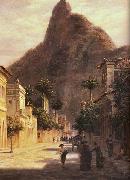 |
Bernhard Wiegandt -- Click Here
|
|
painted Sao Clemente Street, Rio de Janeiro in 1884 |
|
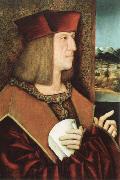 |
bernhard strigel -- Click Here
|
|
Bernhard Strigel (c. 1461 ?C 1528) was a German portrait and historical painter of the Swabian school, the most important of a family of artists established at Memmingen. He was born at Memmingen and was probably a pupil of Zeitblom at Ulm. He stood in high favor with the Emperor Maximilian I, in whose service he repeatedly journeyed to Augsburg, Innsbruck, and Vienna. |
|
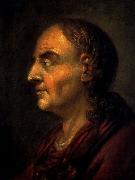 |
Bernhard Rode -- Click Here
|
|
Bernhard Rode (25 July 1725 - died 28 June 1797) was a Prussian artist and engraver well-known for portraying historical scenes and allegorical works. He knew most of the central figures in the Berlin Enlightenment as Friedrich Nicolai and Gotthold Lessing, and the philosophical and political discussions of the Berlin Philosophs informed much of the subject matter of his artistic work. His paintings include several works depicting, in various guises, the King of Prussia Frederick the Great, who ruled the Prussia during much of Rode's lifetime. Rode was director of the Berlin Academy of the Arts from 1783 until his death in 1797.
Rode was the son of a goldsmith Christian Bernhard Rode and his wife, Anna Sophie. The copper engraver Johann Heinrich Rode and the sculptor Philipp Rode were his brothers. He received his earliest artistic training from his father and his earliest training in drawing from a painter, N. Meller. His four-year education at the studio of the court painter Antoine Pesne, an influential painter in Berlin and Brandenburg, was important to his professional development. During his apprenticeship, he learned to paint portraits. In 1748, Rode began a study trip of several years. He spent 18 months in the studio of Jean Restout and Charles Andre van Loo (sometimes known as Carle van Loo or Vanloo). He became acquainted with Jean-Baptiste Deshayes and developed his talent and interest in the medium of history painting. In Venice and Rome, he studied the old masters. In 1755 or 1756, he returned to Berlin, and he married Sophie Luise, but the earliest years of their marriage remained childless. |
|
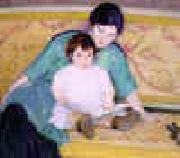 |
Bernhard Gutmann -- Click Here
|
|
German
(Resident in U.S)
1869-1936
|
|
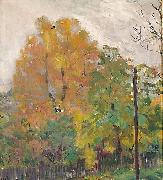 |
Bernhard Folkestad -- Click Here
|
|
1879 - 1933) was a Norwegian essayist and painter. He was born in London, where his father assisted at the Norwegian Seamen Mission. Among his painting teachers were Kristian Zahrtmann and Laurits Tuxen. His paintings Mørkeloftet from 1905, and Høns i høstsol and Grønnsaker from 1906 are all located in the National Gallery of Norway. Among his books are Svingdøren from 1926, Sol og morild from 1929, and Gullfisken from 1933. |
|
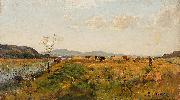 |
Berndt Lindholm -- Click Here
|
|
painted Kor pa bete in 1880(1880)
|
|
 |
Bernat, Martin -- Click Here
|
|
Spanish Early Renaissance Painter, 1454-1497 |
|
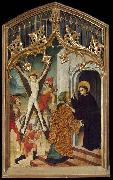 |
Bernat Martorell -- Click Here
|
|
was a Spanish painter, working in an Early Renaissance style. Little is known of his life prior to 1427, though by the mid 15th century he was one of the leading artists in Catalonia.
|
|
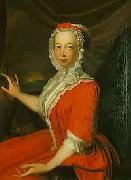 |
Bernardus Accama -- Click Here
|
|
(1697, Burum? - 1756, Leeuwarden) was an eighteenth century Dutch historical and portrait painter, born in Friesland. Active in Leeuwarden.
|
|
 |
Bernardo Zenale -- Click Here
|
|
Italian Painter , ca.1436-1526 |
|
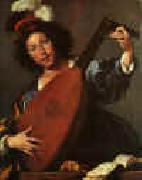 |
Bernardo Strozzi -- Click Here
|
|
1581-1644
Italian
Bernardo Strozzi Galleries
Strozzi was born in Genoa. He was probably not related to the other Strozzi family.
In 1598, at the age of 17, he joined a Capuchin monastery, a reform branch of the Franciscan order. When his father died c1608, he left the order to care for his mother, earning their living with his paintings, which were often influenced by Franciscan teachings, for example his Adoration of the Shepherds (c. 1615) . In 1625, he was charged with illegally practicing as a painter. When his mother died c1630, Bernardo was pressured in court by the Capuchin's to re-enter the order. He was briefly imprisoned in Genoa , and upon release fled to Venice to avoid confinement in a monastery in 1631. He became nicknamed all his life as il prete Genovese (the Genoa priest).
Saint Christopher, by Strozzi.Early paintings, such as The Ecstasy of St Francis show the dark emotionalism of Caravaggio. But by the second decade of the 17th century, while working in Venice, Strozzi had synthesized a personal style which fused painterly influences of the North (including Rubens and Veronese) with a monumental realistic starkness. For example, in the painting The Incredulity of Thomas, the background is muted, yet Jesus' face, haloed and his outline, misty, in a style atypical of Caravaggio. Never as dark as the Caravaggisti, Venice infused his painting with a gentler edge, a style more acceptable to the local patronage, and one derived from his precursors in Venice, Jan Lys (died 1629) and Domenico Fetti (died 1626), who had also fused the influence of Caravaggio into Venetian art. Examples of this style can be found in his Parable of the Wedding Guests (1630),Christ giving keys of Heaven to Saint Peter (1630),, Saint Lawrence distributing Alms at San Nicol?? da Tolentino[7] and a Personification of Fame (1635-6). He was also likely influenced by Velazquez (who visited Genoa in 1629-30).
After a commission to paint Claudio Monteverdi his fame grew, and his portrait paintings included many of the leading Venetians. His pupils and painter strongly influenced by him included Giovanni Andrea de Ferrari (1598-1669), Giovanni Bernardo Carbone, Valerio Castello and, Giovanni Benedetto Castiglione. |
|
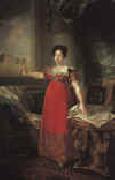 |
Bernardo Lopez -- Click Here
|
|
1801-1874
Spanish
Bernardo Lopez Gallery |
|
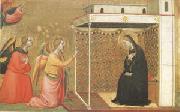 |
Bernardo Daddi -- Click Here
|
|
active in Florence 1320-1348
was an early Italian renaissance painter and apprentice of Giotto. He was also influenced by the Sienese art of Lorenzetti. Daddi's birth date remains unknown. He is first mentioned in 1312. He focused on religious motifs and altarpieces. A triptych he painted in 1328 is in the Uffizi, and there are several panels in National Gallery of Art and the Walters Art Gallery. Daddi became the leading painter of Florence during his generation. His last work dates from 1347, |
|
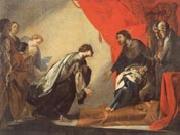 |
Bernardo Cavallino -- Click Here
|
|
Italian Baroque Era Painter, ca.1616-1656
was an Italian painter of the Baroque period, working in Naples. Born in Naples, he likely died during the plague epidemic in 1656. While his paintings are some of the more stunningly expressive works emerging from the Neapolitan artists of his day, little is known about the painter's background or training. Of eighty attributed paintings, less than ten are signed. He worked through private dealers and collectors whose records are no longer available. It is said that he trained with Massimo Stanzione, befriended the painter Andrea Vaccaro, and was influenced by Anthony Van Dyck, but his paintings could also be described as equidistant from Caravaggio and Bartolome Esteban Murillo in styles; tenebrism enveloped with a theatrical sweetness, a posed ecstasy and feeling characteristic of the high Roman baroque statuary. He is known to have worked in Neapolitan circles strongly influenced by Stanzione, which included Artemisia Gentileschi, Francesco Francanzano, Agostino Beltrano and Francesco Guarino. One of his masterpieces is the billowing maiden Virgin at the Brera Gallery in Milan. Passive amid the swirling, |
|
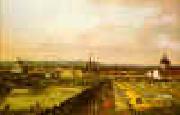 |
Bernardo Berlotto -- Click Here
|
|
1721-1780
Italian
Bernardo Berlotto Gallery |
|
|